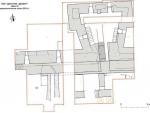Summary (English)
DEULTUM (Lyudmil Vagalinski – lvagalin@techno-link.com) The explorations of the Late Antique fortification tower with trapezoid layout, preserved up to 4 m in height, continued. Part of the northern fortification wall of the Roman period was discovered. The wall was 2.48 m wide, built of roughly-cut stones bonded with mortar with an emplectum of uneven stones. Later on, the Late Antique fortification wall was built on it. A public building with arches constructed of bricks was built to the south of the fortification wall. The building was burned after AD 383 and subsequently it was reconstructed and used to accommodate dolia. Then the building was burned again. The Late Antique northern fortification wall with the tower with trapezoid layout was built after AD 457. The wall was 2.20 m wide. The first period ended with a fire that occurred after AD 491. The second period of the northern Late Antique wall with a tower began with a repair. Rooms adjacent to the inner side of the wall were built. The northern fortification wall was destroyed by a fire that occurred after AD 574, probably during any attack by the Avars. During the 7th – 8th centuries AD, ramshackle buildings were constructed over the debris of the northern fortification wall with a tower. The finds from the excavations included fragments from inscriptions, 238 Roman and Early Byzantine copper and bronze and two silver coins, fibulae, terracotta lamps, a bronze lamp, weapons, a bone figurine of Isis and Horus, a bronze appliqué with encrusted silver decoration and sherds. Meat from wild animals and grain were stored in the fortification tower. Carbonized rye, barley, common wheat and einkorn wheat were documented in the Early Byzantine layers.
- Lyudmil Vagalinski - Archaeological Institute with Museum
Director
Team
Research Body
- Archaeological Institute with Museum






![Download [PDF]](/excavation/skins/fasti/images/results/download_sml.png)
